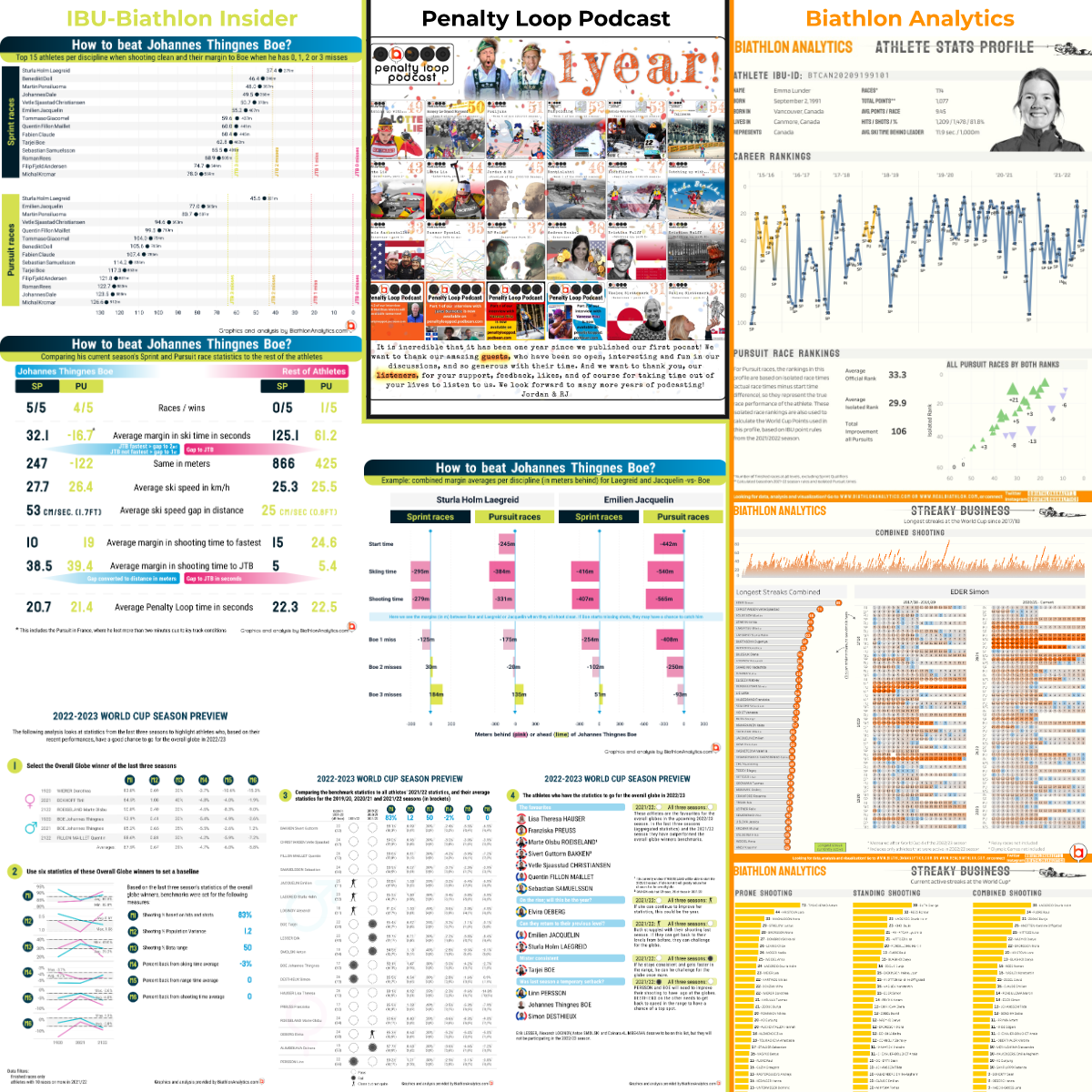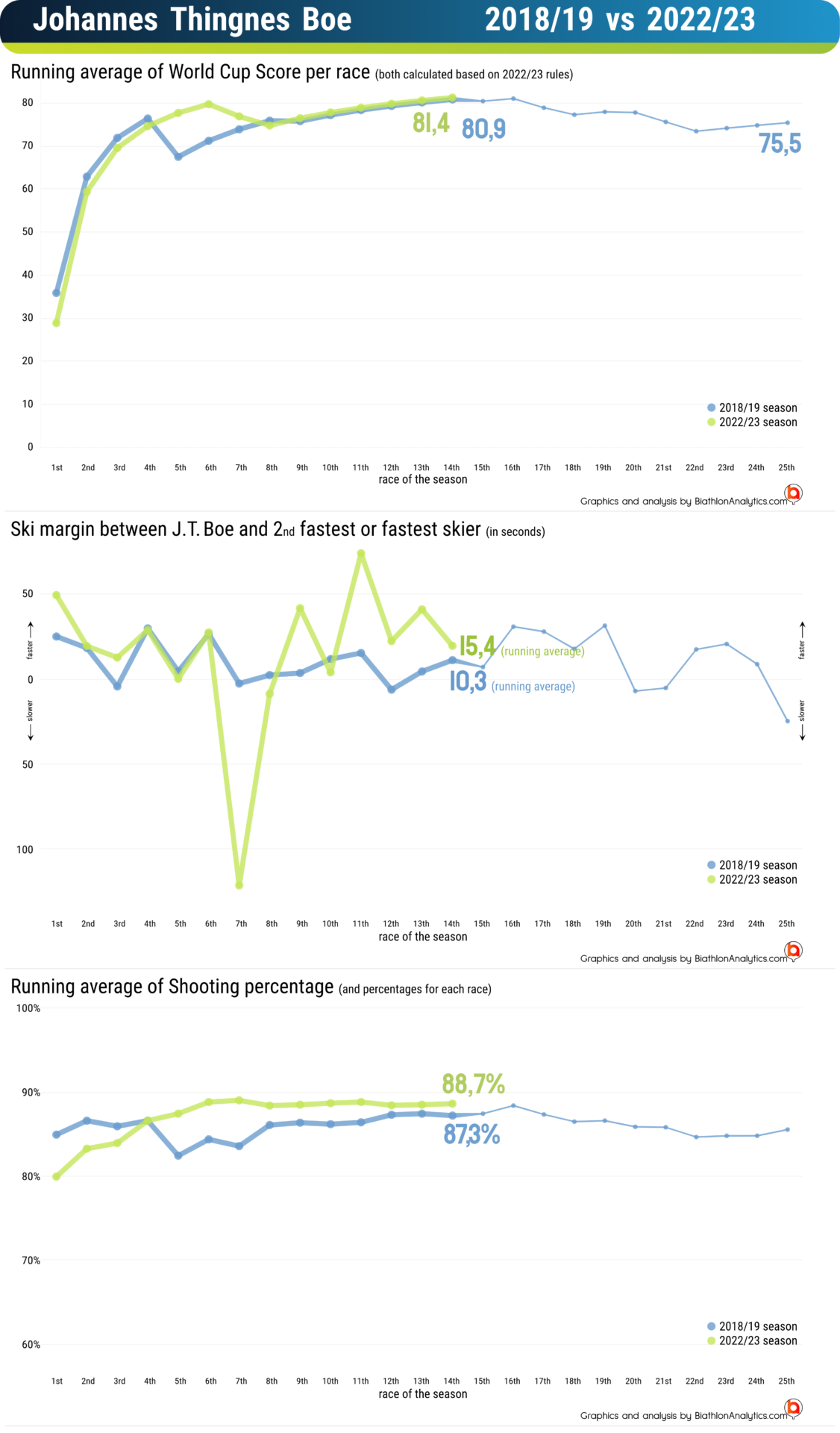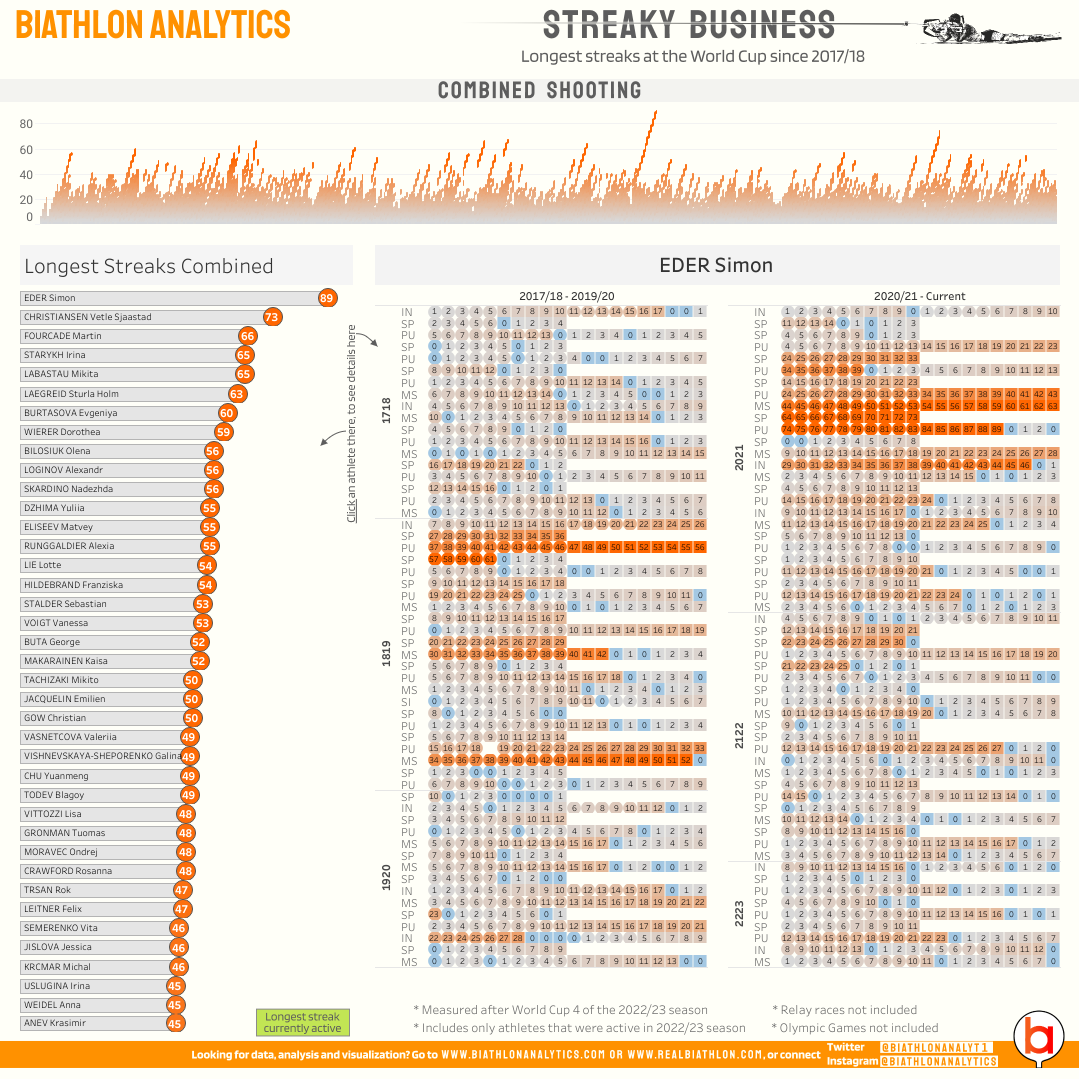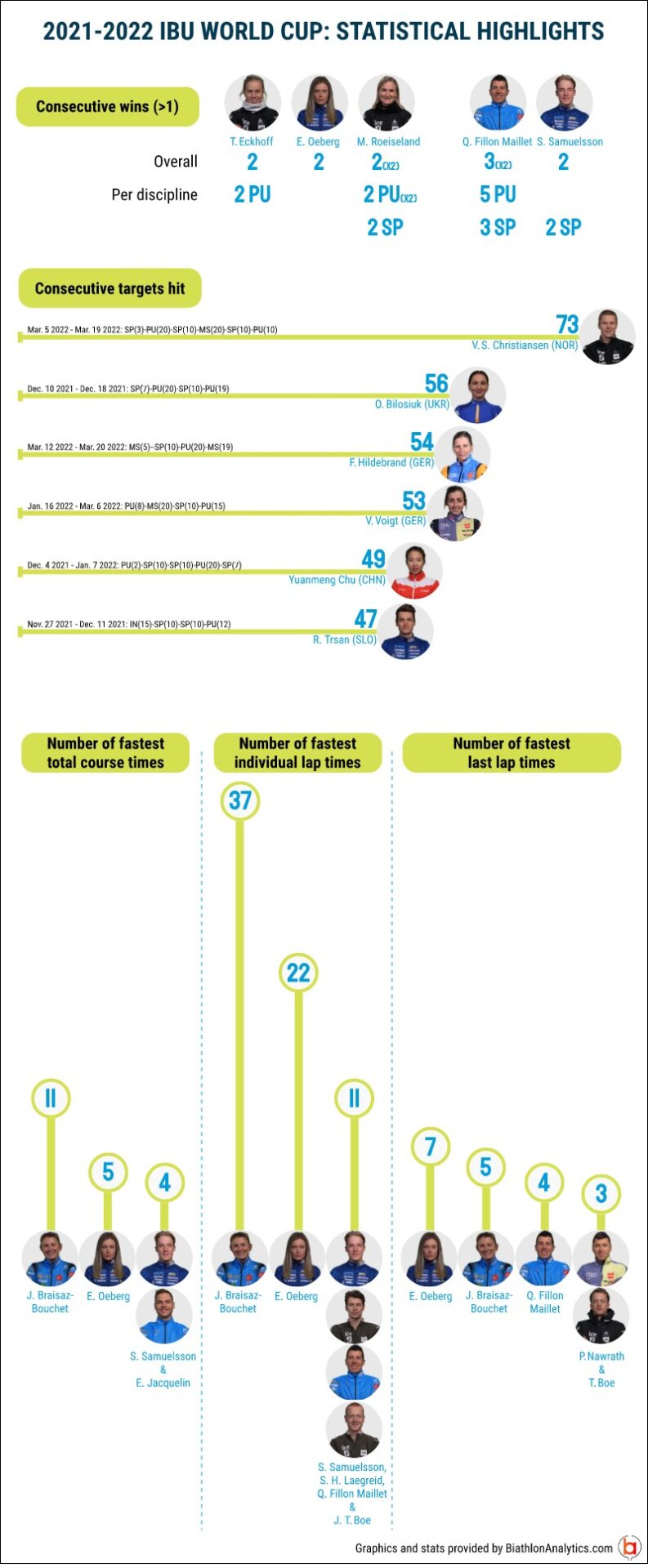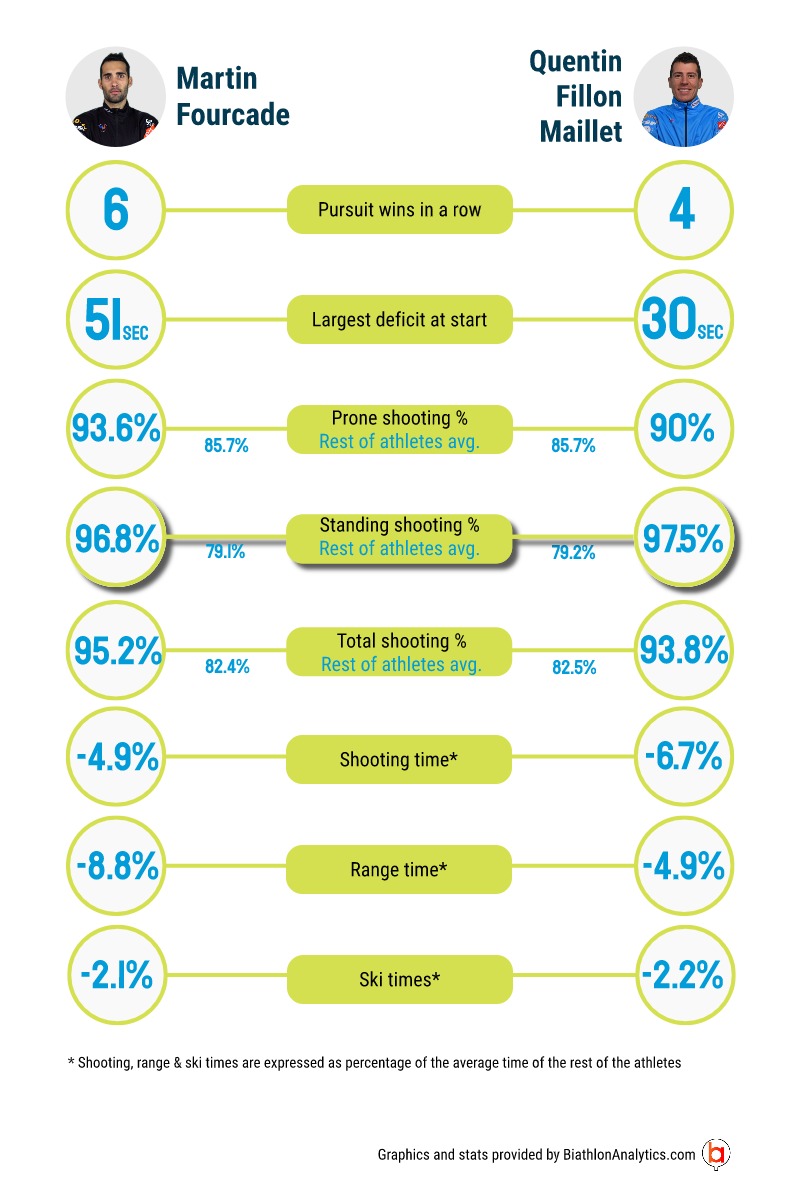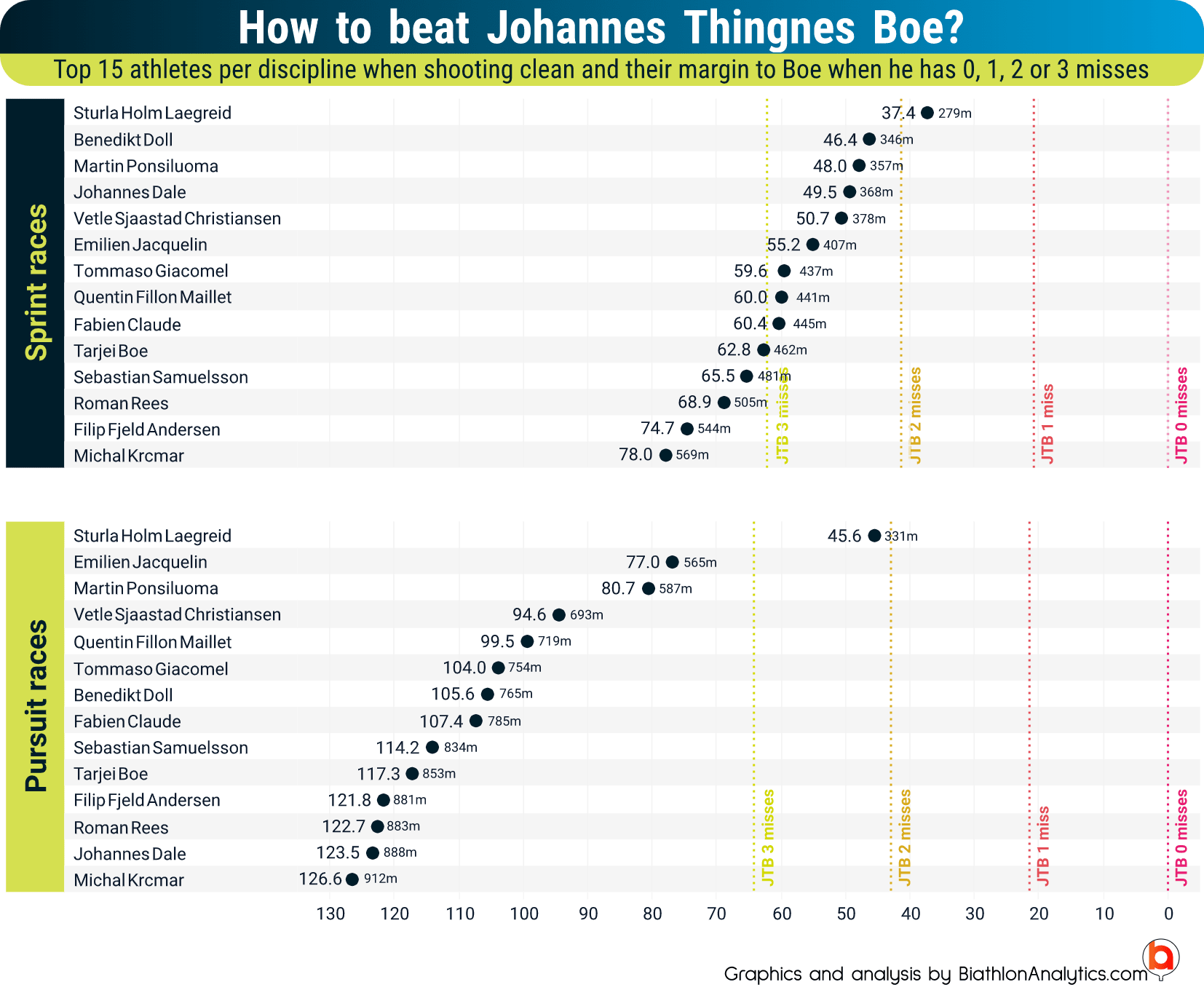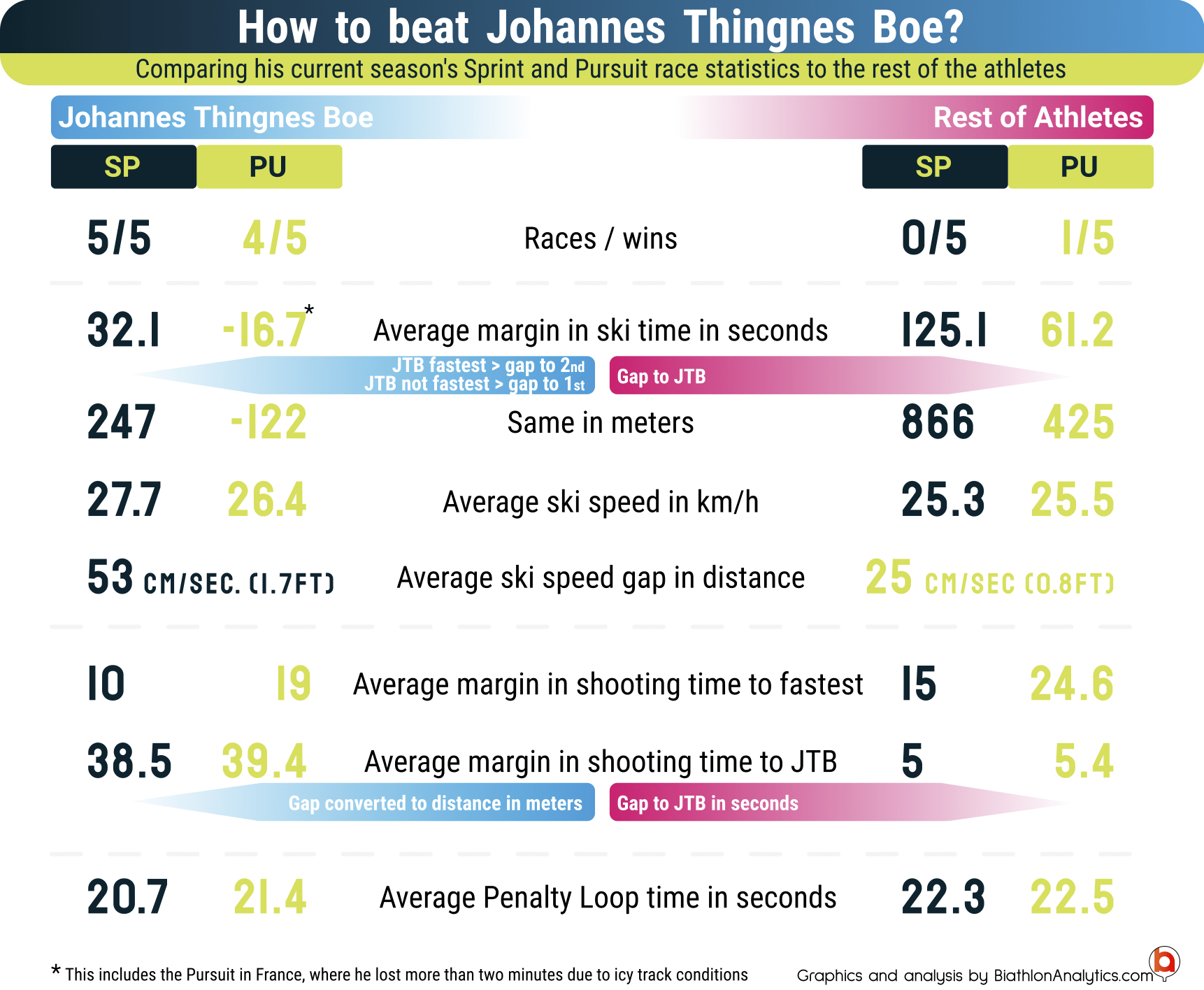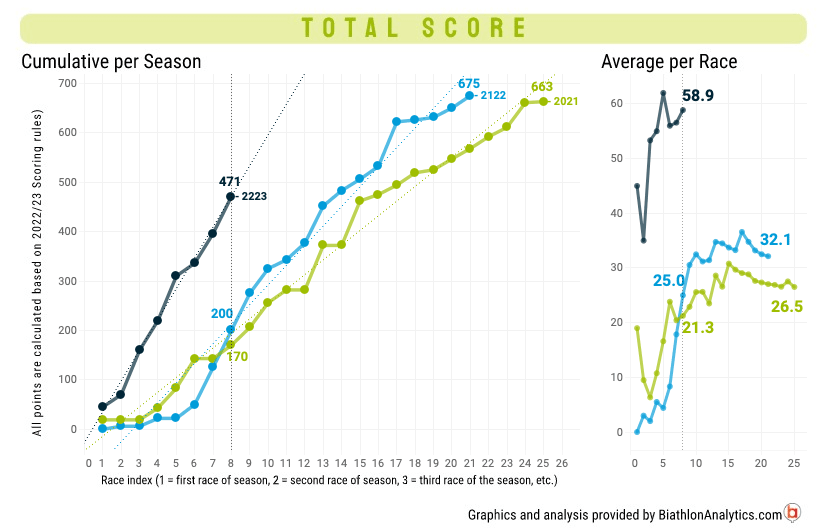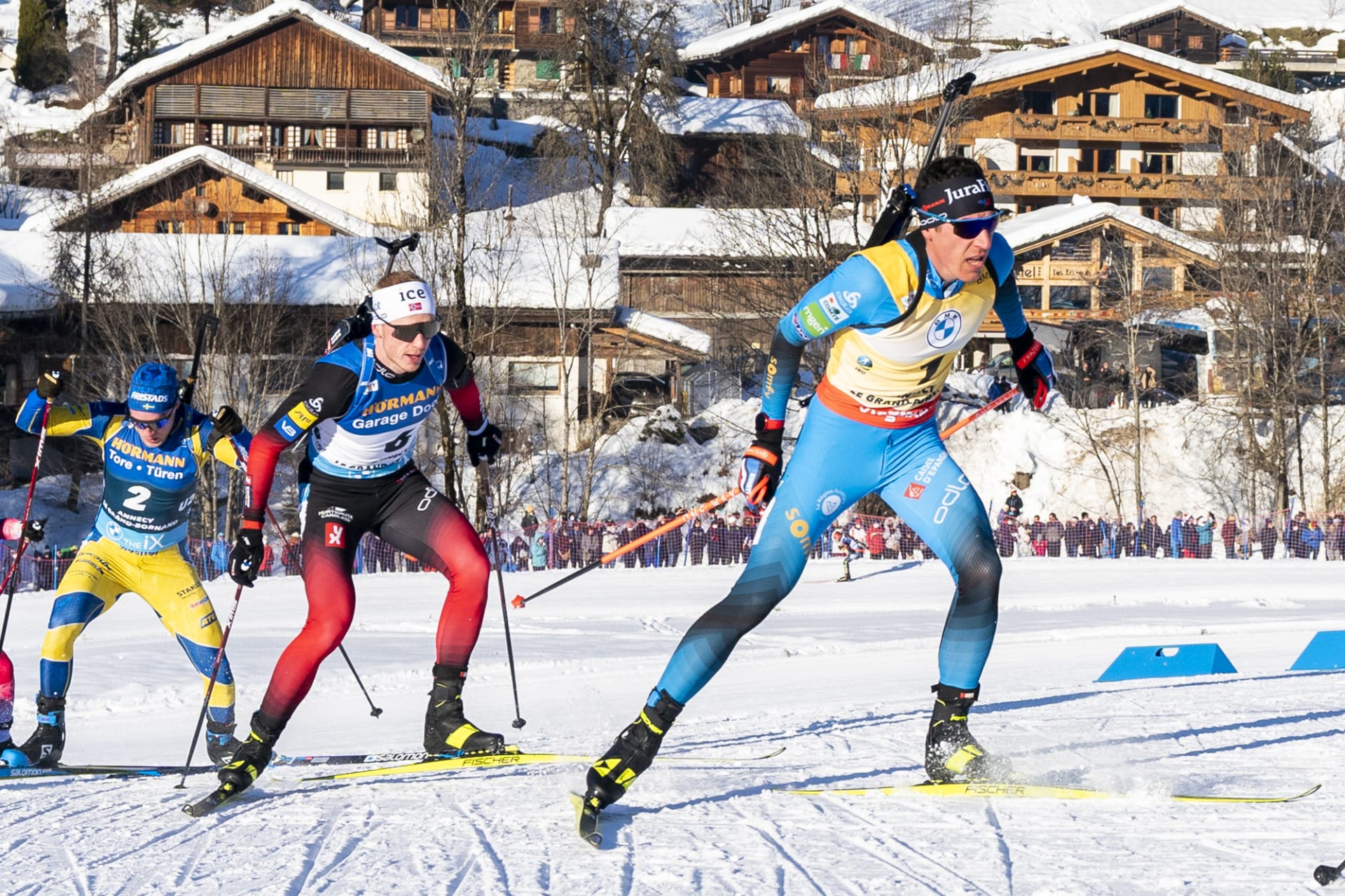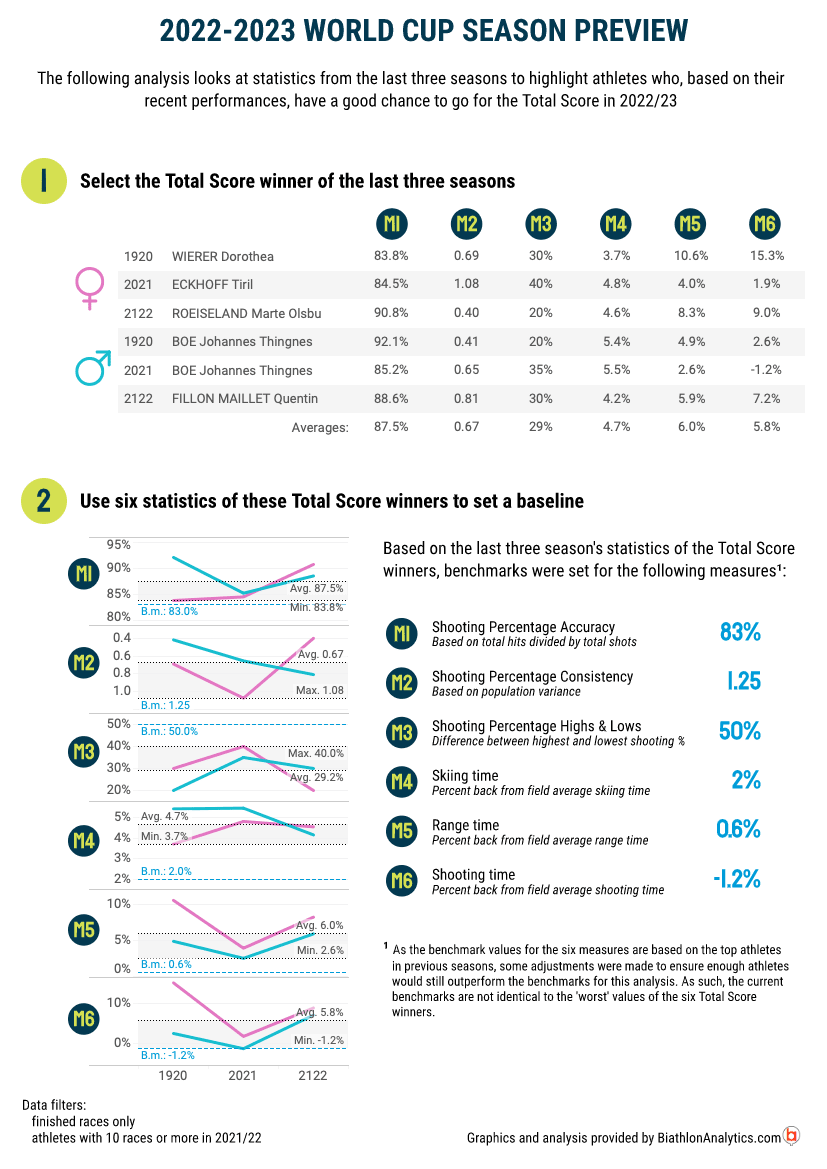Below are some examples of publications I did for IBU’s BiathlonWorld website, the IBU Biathlon Insider, other clients and for myself. Click the dropdown icon to see the full article.
WHO CAN BEAT JOHANNES THINGNES BOE?
www.BiathlonWorld.com, February 11, 2023 (full link)
JT Boe worked harder than ever in the summer and hit a streak of skiing excellence rarely seen in biathlon. His shooting accuracy is also the highest in JT’s career. With 11 wins in 14 BMW IBU World cup competitions, the most intriguing question before the start of the men’s program in Oberhof 2023 must be: How to beat Johannes?
The Methodology
We have used all the competition data for the Top 15 athletes from the 5 Sprints and Pursuits from Trimesters 1 and 2. For each competition and athlete, we analyzed the following metrics:
- skiing time (seconds behind the leader and the gap between JT Boe and every other athlete);
- shooting time (the gap between JT Boe and every other athlete);
- average penalty time per athlete per competition;
- for pursuit races, the start time difference to JT Boe (he started all 5 pursuits first out of the gate);
- ski speed for every athlete.
We then aggregated all data points per athlete and per discipline. In the end, we used the aggregate to analyze and visualize JT Boe’s margins on his competitors individually and as a group of his challengers.
Key takeaways
Average ski speed gap in seconds
- In the Sprint, JT Boe is 125.1 seconds faster than the average of the field.
- In the Pursuit, JT Boe is 61.2 seconds faster than the average of the field.
Average ski speed in km/h
- In the Sprint. JT Boe’s average ski speed is 27.7 km/h compared to 25.3 km/h for the rest of the field.
- In the Pursuit, JT Boe’s average ski speed is 26.4 km/h compared to 25.5 km/h for the rest of the field.
Average ski speed gap in meters
- In the Sprint, JT Boe is on average gaining 0.53 meters every second over the average of the field.
- In the Pursuit, JT Boe is on average gaining 0.25 meters every second over the average of the field.
Shooting: A (small) window of opportunity for others
- In the Sprint, JT Boe is 10 seconds slower than the fastest shooter. The rest of the field is 15 seconds slower than the fastest shooter.
- In the Pursuit, JT Boe is 19 seconds slower than the fastest shooter. The rest of the field is 24.6 seconds slower than the fastest shooter.
Penalty loop: JT gains over the rest (again)
- In the Sprint, JT Boe skis a penalty loop in 20.7 seconds compared to 22.3 seconds for the rest of the field.
- In the Pursuit, JT Boe skis a penalty loop in 21.4 seconds compared to 22.5 seconds for the rest of the field.
What Laegreid (and Jacquelin) need to do and hope for
This chart explains – step by step – the margin between JT Boe and Sturla Holm Laegreid and Emilien Jacquelin as his – perhaps – most dangerous challengers in Oberhof. We analyzed Jacquelin as somebody who has JT’s number when they find each other shoulder-to-shoulder on the shooting range or in the tracks and because he will aim to win back-to-back-to-back Pursuit titles in Oberhof.
Based on data analysis from Trimesters 1 and 2, JT Boe is unbeatable in the Sprint if he hits nine targets (or 10) because his combined skiing time, shooting time, pursuit start time, and penalty loop time (with by far the most considerable contributor his skiing) averages give him a 37.4-second (279 meters) advantage over the closest challenger – Sturla Holm Laegreid – before the competition begins.
Encouraging news for Laegreid: JT won just twice in the Sprint in Oberhof while Laegreid collected three podiums in his two full-time seasons in the BMW IBU World Cup (2020/2021 and 2021/2022). JT tends to get tense when the wind gusts become unpredictable. This is often the case in Arena am Rennsteig’s shooting range.
Laegreid needs to shoot clean and ski with the speed average from Trimesters 1 and 2 and hopes that Boe misses 2 targets in the Sprint and 3 in the Pursuit – to have a chance to win. And take a Gold medal in Oberhof.
Jacquelin’s chances for a third consecutive Pursuit Gold seem quite remote as he needs a perfect race and JT one with four misses.
Graphics and analysis: Biathlon Analytics
JULIA SIMON’S YELLOW SECRET
www.BiathlonWorld.com, IBU Biathlon Insider, December 17, 2022 (full link)
It took Julia Simon two years to finally understand and internalize the teachings of Jean-Paul Giachino, who replaced equally successful Franck Badiou before the start of the 2020/2021 season.
Simon performed with 72% accuracy in the prone in her first season under Giachino’s tutoring and 84% last season. She has shot 75 times in the prone and cleared all but one target in the first weeks of the season! That strengthened her self-confidence, and she will go to the Christmas break as a Total Score leader, the woman in yellow.
We have analyzed Julia’s points at the end of Trimester 1 for this and the previous two seasons to see the correlation between her shooting performance and world cup points won per competition. We have used the new point system and adjusted Julia’s score from the last two seasons accordingly.
She won 62 points per competition in Trimester 1 this season, compared to 32.1 points in the 2021/2022 and 26.5 points in the 2020/2021 season.
We then broke down Julia’s shooting to the prone, standing, and combined accuracy. Her accuracy in the prone went from 72% in the 2020/2021 season to 84% in 2021/2022 and is currently at 99%!
Her accuracy in the standing went from 81% in the 2020/2021 season to 78 in 2021/2022 and is currently at 85%. Julia’s combined accuracy at the end of the 2020/2021 season was 77%, a season after at 81%. It is currently at 92%.
We also analyzed the change in her shooting speed from Trimester 1 in the 2020/2021 season – when she started to apply Giachino’s input – until the end of Trimester 1 this winter. We can observe that her speed first increased and then fell dramatically – together with Julia’s wavering confidence. It picked up this season again.
Data analysis and visuals: Robert Weise/Biathlon Analytics
DATA’S TOTAL SCORE FAVOURITES
www.Biathlonworld.com, IBU Biathlon Insider, November 21, 2022 (full link)
We did a deep dive into the performance of the BMW IBU World Cup’s best athletes for the past three seasons, using key metrics that define a Total Score winner or challenger.
Based on the crunched numbers, we also composed a table that breaks down the athletes into favourites, their principal challengers, and the athletes who would want to regain their winning ways in the 2022/2023 season.
Analysis’s benchmarks
As a starting point, we analyzed Women’s and Men’s Total Score Winners for 2019/20, 2020/21, and 2021/22 seasons based on the following season-average statistics:
M1 Shooting percentage accuracy (based on total targets closed, divided by all shots taken)
M2 Shooting percentage consistency (based on the population variance)
M3 Shooting percentage highs & lows (difference between the highest and the lowest shooting percentage)
M4 Skiing time/speed (skiing speed of the athlete compared to the average skiing speed of the field)
M5 Range time (range time compared to the average range time)
M6 Shooting time (shooting time compared to the average shooting time)
Gray bandwidths in Chart 2 indicate the areas used to determine baseline values for six benchmarks (M1-M6).
In short: performing in the gray bandwidth – or above it – in as many of these measures as possible gives an athlete an above-average chance of winning the Total Score title.
Favourites and challengers
We then analyzed the athletes that either:
– outperformed the benchmarks,
– were close to the benchmarks;
– missed them last year but outperformed them on average in the last three years.
In the end, we compiled a list of favorites, challengers, and athletes who would want to regain their form to fight for the Total Score title in the coming winter.
Data and visuals: Robert Weise, Biathlon Analytics
